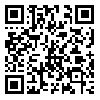1. Li Y, Xu Y, Chen Z. Effects of the behavioral inhibition system (BIS), behavioral activation system (BAS), and emotion regulation on depression: a one-year follow-up study in Chinese adolescents. Psychiatry Res. 2015;230(2):287–93. [
DOI]
2. Seid SH, Rajaei A, Borjali M. The effectiveness of group behavioral activation therapy on depression and identity crisis in patients with multiple sclerosis. Journal of Psychological Science. 2020;19(95):1507–71. [Persian] [
Article]
3. O'Mahen HA, Moberly NJ, Wright KA. Trajectories of change in a group behavioral activation treatment for severe, recurrent depression. Behav Ther. 2019;50(3):504–14. [
DOI]
4. Dimidjian S, Goodman SH, Sherwood NE, Simon GE, Ludman E, Gallop R, et al. A pragmatic randomized clinical trial of behavioral activation for depressed pregnant women. J Consult Clin Psychol. 2017;85(1):26–36. [
DOI]
5. Amiri S, Yaghobi A, Gharehveysi S. An investigation into the relationships between emotional intelligence, behavioral activation system (BAS), behavioral inhibition system (BIS), and dark triad traits (machiavellianism, narcissism, and Psychopathy. Journal of Personality and Individual Differences. 2015;4(10):137–58. [Persian]
6. Soucy Chartier I, Provencher MD. Behavioural activation for depression: efficacy, effectiveness and dissemination. J Affect Disord. 2013;145(3):292–9. [
DOI]
7. Dashti N, Abolghasemi A. The role of self- regulation, selfpresentation and dark triad personality in predicting social networking sites addiction in students of Ardabil university of medical sciences. Journal of Knowledge and Research in Applied Psychology. 2018;19(2):11–21. [Persian] [
Article]
8. Mirzahoseini H, Arjmand S, Monirpour N. Yang schema model test to explain eating problems in people with personality disorders. Journal of Psychological Science. 2019;18(80):941–8. [Persian] [
Article]
9. Manteghian E, Saberi H, Bashardoost S. Explaining the relationship between dark traits of personality (narcissism - psychopath - machiavellianism) and job burnout based on the intermediary role of perceived stress. Journal of Psychological Science. 2019;18(78):727–35. [Persian] [
Article]
10. Jonason PK, Strosser GL, Kroll CH, Duineveld JJ, Baruffi SA. Valuing myself over others: the dark triad traits and moral and social values. Pers Individ Dif. 2015;81:102–6. [
DOI]
11. Jones DN, Paulhus DL. Different provocations trigger aggression in narcissists and psychopaths. Soc Psychol Personal Sci. 2010;1(1):12–8. [
DOI]
12. Wiens TK, Walker LJ. Examining the relationship between bright and dark personality traits in two management samples. Pers Individ Dif. 2019;141:92–100. [
DOI]
13. Mosalman M, Hoseini A, Sadeghpoor M. Prediction of addiction readiness based on behavioral activation and inhibition of systems (BIS/BAS) and cognitive abilities among students in amol institute of higher education 2017–2018. Military Care Sciences. 2018;5(2):146–55. [Persian] [
DOI]
14. Mazzucchelli T, Kane R, Rees C. Behavioral activation treatments for depression in adults: A meta-analysis and review. Clinical Psychology: Science and Practice. 2009;16(4):383–411. [
DOI]
15. Jones DN, Weiser DA. Differential infidelity patterns among the dark triad. Pers Individ Dif. 2014;57:20–4. [
DOI]
16. Sharifiniya MA, Haroonrashidi H. The relationship between the dark traits of personality and emotional expressiveness with satisfaction of life among the military personnel in Ahvaz, Iran. Journal of Military Psychology. 2020;11(41):41–9. [Persian] [
Article]
17. Kianersi F, Mojabi N. Examining the contribution of sense of coherence and self-compassion in predicting flourishing in university students. Journal of New Thoughts on Education. 2018;14(2):247–61. [Persian] [
Article]
18. Roth RA, Suldo SM, Ferron JM. Improving middle school students' subjective well-being: efficacy of a multicomponent positive psychology intervention targeting small groups of youth. School Psychology Review. 2017;46(1):21–41.
19. Keyes CLM. Promoting and protecting mental health as flourishing: a complementary strategy for improving national mental health. Am Psychol. 2007;62(2):95–108. [
DOI]
20. Faulk KE, Gloria CT, Steinhardt MA. Coping profiles characterize individual flourishing, languishing, and depression. Anxiety Stress Coping. 2013;26(4):378–90. [
DOI]
21. Shankland R, Rosset E. Review of brief school-based positive psychological interventions: a taster for teachers and educators. Educ Psychol Rev. 2017;29(2):363–92. [
DOI]
22. Huppert FA, So TTC. Flourishing across Europe: application of a new conceptual framework for defining well-being. Soc Indic Res. 2013;110(3):837–61. [
DOI]
23. Guney S. The Positive Psychotherapy Inventory (PPTI): reliability and validity study in Turkish population. Procedia - Social and Behavioral Sciences. 2011;29:81–6. [
DOI]
24. Gonzales TR, Ehrenzweig Y, Gracida ODS, Hernandez CBE, Mora GL, Martinez AJ, et al. Promotion of individual happiness and wellbeing of students by a positive education intervention. Journal of Behavior, Health & Social Issues. 2013;5(2):79–102. [
DOI]
25. Gokcen N, Hefferon K, Attree E. University students'constructions of 'flourishing' in British higher education: an inductive content analysis. International Journal of Wellbeing. 2012;2(1):1–21. [
DOI]
26. Elfrink TR, Goldberg JM, Schreurs KM, Bohlmeijer ET, Clarke AM. Positive educative programme: A whole school approach to supporting children's well-being and creating a positive school climate: a pilot study. Health Education. 2017;117(2):215–30.
27. Hooman HA. Structural equation modeling with LISREL application. Tehran: Samt Pub; 2018. [Persian]
28. Carver CS, White TL. Behavioral inhibition, behavioral activation, and affective responses to impending reward and punishment: The BIS/BAS Scale. J Pers Soc Psychol. 1994;67(2):319–33. [
DOI]
29. Khanjani Z, Mohammadi F, Hashemi T, Bakhshipour A, Beyrami M. Tasire system haye maghzi raftari va avatef bar neshane haye ab'aadi vasvasi jabri [The effect of behavioral brain systems and emotions on the dimensional symptoms of OCD]. Journal of Kermanshah University of Medical Sciences. 2014;18(2):80–91. [Persian]
30. Ghamrani A, Samadi M, Taghinejad M, Shamsi A. The study of the validity and reliability of The Dark Personality Scale in students. Journal of Psychological Methods and Models. 2015;6(20):73–86. [Persian] [
Article]
31. Soleymani S, Alidoosti F, Rezaiee AM, Barani M. Psychometric properties of The Flourishing Questionnaire (HFQ) among Iranian students. Journal of Educational Measurement. 2017;7(27):83–102. [Persian] [
Article]
32. Becker JM, Klein K, Wetzels M. Hierarchical latent variable models in PLS-SEM: guidelines for using reflective-formative type models. Long Range Planning. 2012;45(5–6):359–94. [
DOI]
33. Dehghani Y, Hekmatiyan Fard S. The role of early maladaptive schemas, behavioral activation – inhibition systems, and cognitive emotion regulation strategies in predicting the social anxiety within the students with learning disorder. Journal of Exceptional Children. 2020;19(4):77–90. [Persian] [
Article]





